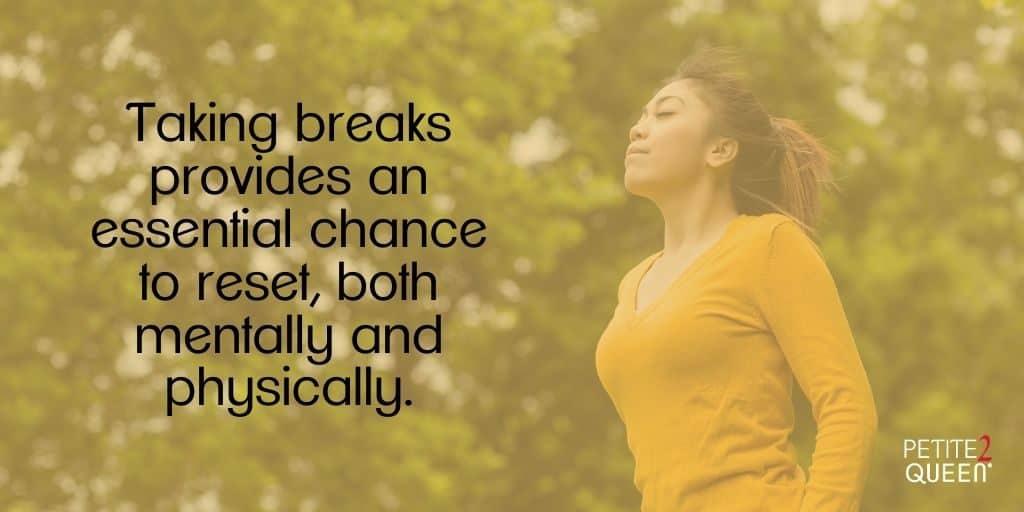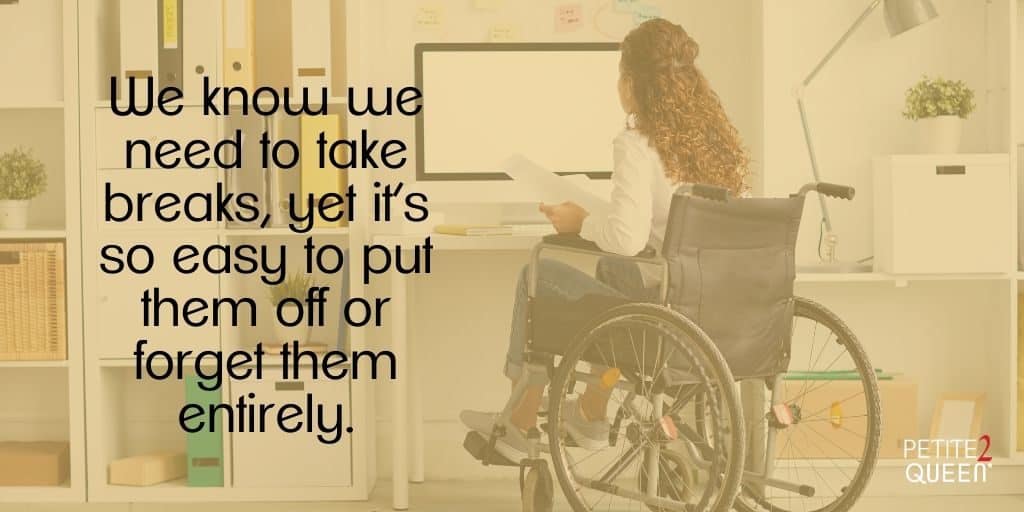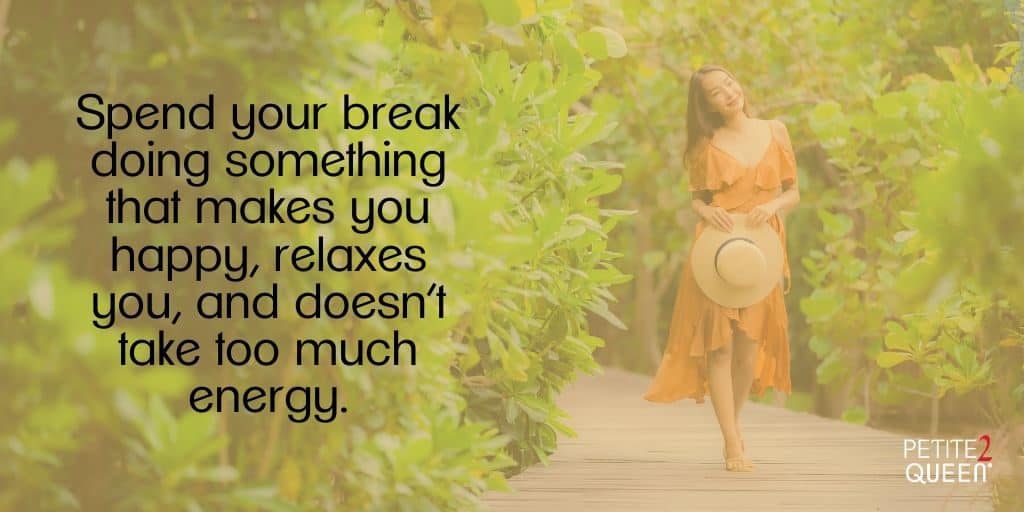We all know we should take breaks, yet so many of us cut our time off short or out entirely. When the workload is growing by the minute, it can feel like we’re simply too busy to take a break. We might think we’re being more productive by focusing on our tasks rather than taking a breather, but the opposite couldn’t be truer. Believe it or not, taking a little time off each day actually improves performance. Here’s how taking breaks helps, what you can do to tear yourself away from the desk, and how best to spend those breaks.
Breaks: Good Both Personally & Professionally
People aren’t worker drones or robots. But, like those machines built to work, we do need breaks every now and then or we’ll burn out. We need energy to keep going. Sometimes that comes in the form of food or sleep, but we also need moments to simply rest before moving on to the next task.
What happens if you don’t take breaks? First and foremost, you’ll become mentally fatigued. This leads to lessened ability to focus and absorb information, increased irritability, and decreased creativity. This means you’re working less efficiently, leading to longer time needed to complete a task and complete it well. The effects of endless working also manifest physically. We’re more likely to experience pain, and it becomes longer-lasting. This, too, slows us down, both on the job and off it. Whether it’s headaches or pain in the neck, back, or feet, it becomes a distraction from the job at hand.
Taking breaks provides an essential chance to reset, both mentally and physically. It’s an opportunity to destress, clear your mind, and find renewed energy. Once you get back to work, you’ll be more focused and more creative. You’ll be able to look at things a different way, allowing you to get past mental roadblocks and move forward on a project you may have been stuck on. Ultimately, simply taking a break makes you more productive. The time spent taking the break is time saved on inefficient rework; moreover, you’ll feel better.

Taking Breaks is Hard… But Necessary
I’ll be the first to admit that I’m bad at taking breaks. It can take me a while to get focused on a creative project, and once I get into that groove, it’s hard for me to snap back out of it. In all honesty, I don’t want to for fear that once my break is over, I won’t be able to get back into that productive flow. I know I need to take breaks, yet it’s so easy to put them off or forget them entirely.
If this sounds like you, think about how you can enforce a strict Take Your Breaks policy on yourself. Here’s what works for me: I schedule breaks into my day. Set up an alarm – on your computer or phone – to remind you to take a quick break. When you schedule these breaks is up to you. What works best with your workflow or your working style?
For some, the Pomodoro Technique is particularly efficient. With this schedule, you work for 25 minutes, then take a 5-minute break. Every four Pomodoros, take a longer break lasting about 30 minutes.

Alternately, you may work for longer chunks of time; every 90 minutes, take a 20-minute break. If neither of these schedules is quite right for you, try something in between. On the other hand, you may have to take breaks according to the schedule at your organization. It’s common for employees to be given two 15-minute breaks in addition to a longer lunch break each day. This can also vary depending on the length of your shift.
Realize, too, that each country and state will have its own laws about how often you should take breaks and how long they should be. Most employers encourage you to take breaks, at least according to the local laws, but it doesn’t hurt to check on those laws yourself to make sure you’re being afforded enough break time during the day.
How Best to Spend Breaks?
Now that you’re on board with taking those breaks you so deserve, you might be wondering the best way to spend them. You will have some limitations on what you do during these breaks, depending on how much time you have allotted yourself and where you work. However much time you have, try to spend your break recharging – both mentally and physically.
First, I lean towards spending my break doing something different from what I do for work. In my case, I’m sitting in my office chair for 8+ hours a day. That means that on breaks, it’s important to stand up, walk around, stretch, and just get my body moving. If you have time for a walk in the park, get out there and get the blood flowing. It also helps to breathe in fresh air. On the other hand, if you’re on your feet all day, it’s important to give yourself a chance to relax a bit. Take a seat – or even lay down – and rest your feet.
Those of us who work on the computer all day know that the glowing screen can start to wear out your eyes after a while. Whenever you take a break, try to spend it on something that isn’t digital. Even between breaks, look away from your computer every so often to rest your eyes. Keep in mind the 20-20-20 rule: Every 20 minutes, look at something 20 feet away for 20 seconds. This will help keep your eyes from straining too much.
If you’re not glued to the screen during work, though, go ahead and check Facebook or play a game on your phone while you’re on break.

Spend your break doing something that makes you happy, relaxes you, and doesn’t take too much energy. The idea is to get your mind off work for a few minutes. Do something that lifts your mood and gives you a chance to mentally unwind. Look at cat videos on YouTube; read a chapter of that new novel you picked up; take in the scenery of the park next-door. If you have a flexible schedule that permits longer breaks, you may even want to hit the gym.
Finally, don’t forget to get a bite to eat! A snack or coffee can be a huge pick-me-up in the middle of the day. When you get lunch, be sure to step away from the desk and focus on the meal in front of you, not the tasks at hand. Breaks need to take you away from work – literally or figuratively – and you can’t do that if you won’t pull yourself away from your workstation.
Taken correctly, your breaks will leave you feeling refreshed and reenergized. You’ll be more alert when you get back to work. You’ll also be more creative, focused, and efficient. Finally, you’ll feel better and less stressed, leading to better performance. Breaks are important for your productivity at work, but they’re also vital for your own well-being. You need a break. Why not take one right now?
Resources

Amanda Whitbeck is Vice President of Operations at Petite2Queen. Since earning her master’s degree in Global Entertainment & Music Business from Berklee College of Music, Amanda has played key roles facilitating growth at start-ups. She’s also worked in diverse sectors of the music industry, from live events promotion to entertainment journalism. She brings her expertise in music business, writing, and website development to Petite2Queen.


Comments 1
Pingback: Listening Strategies to use Regarding Podcasts – Emily Ninan